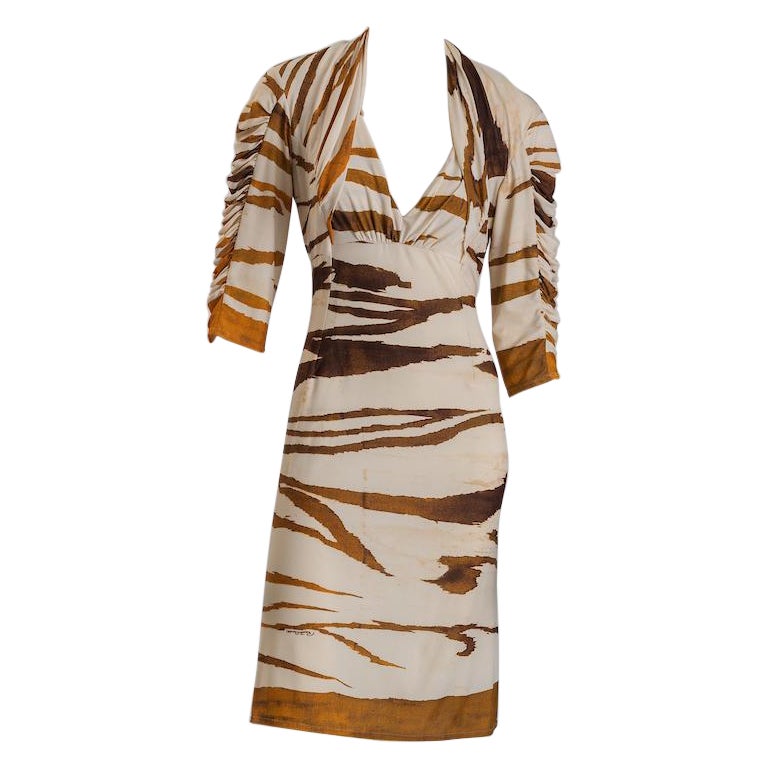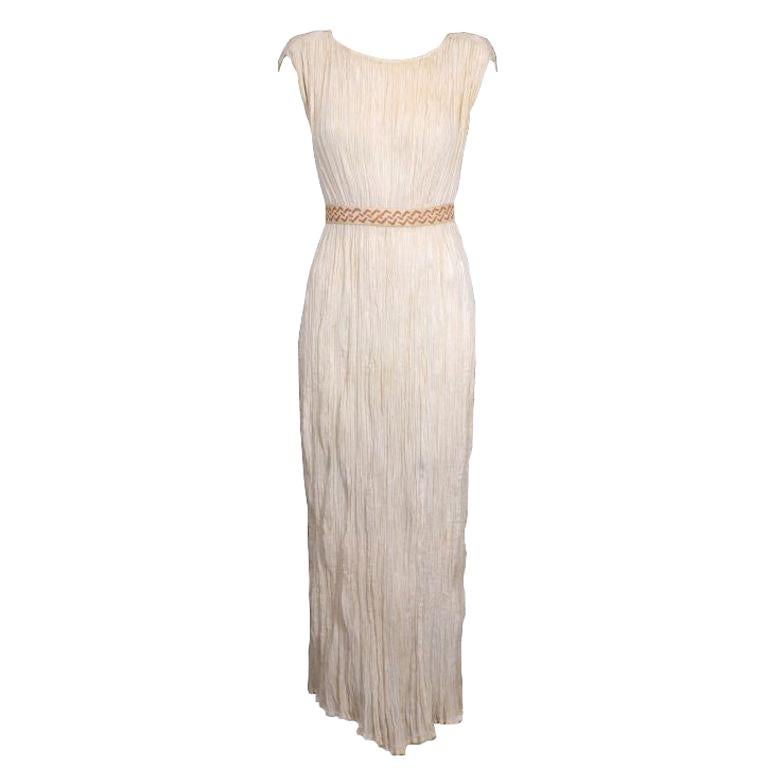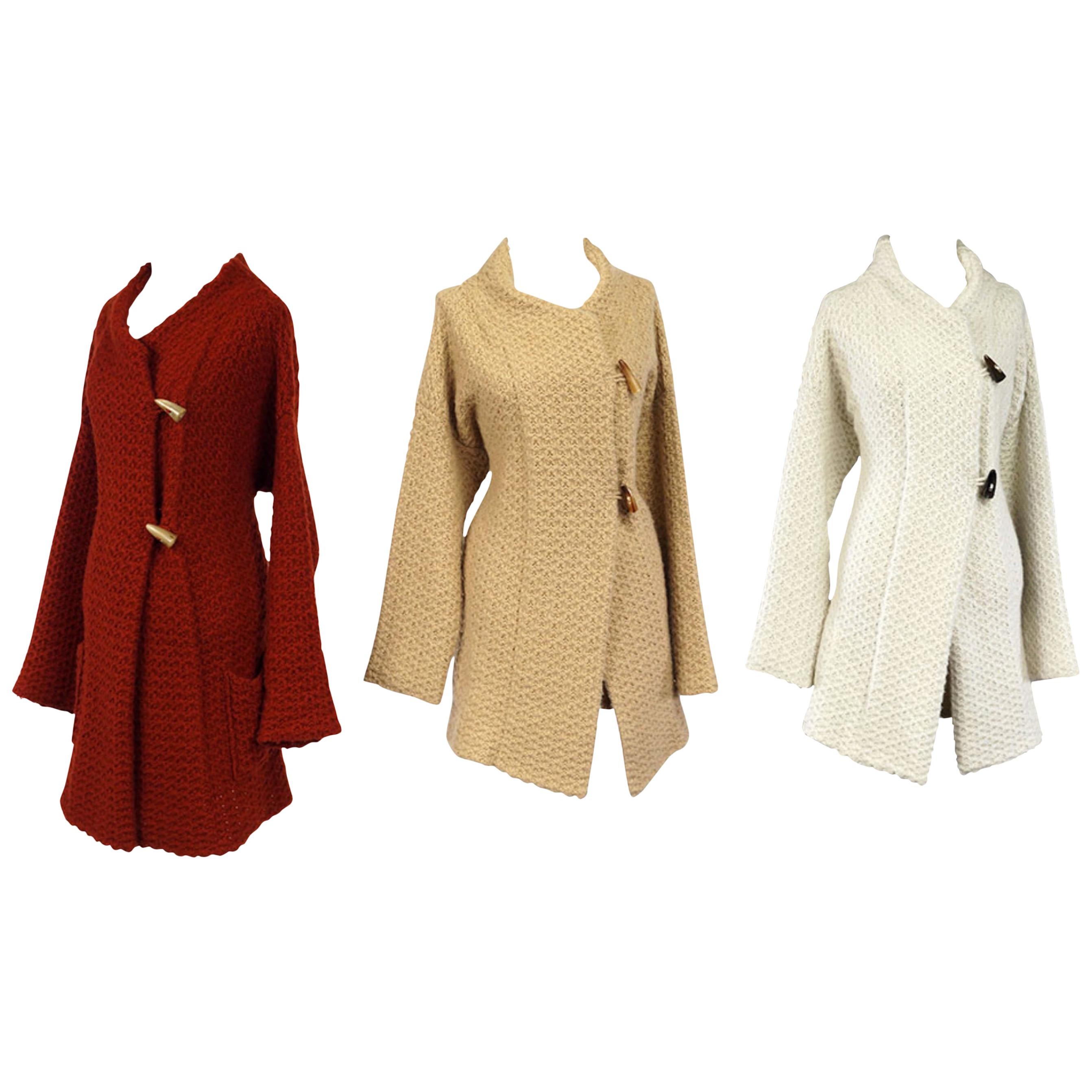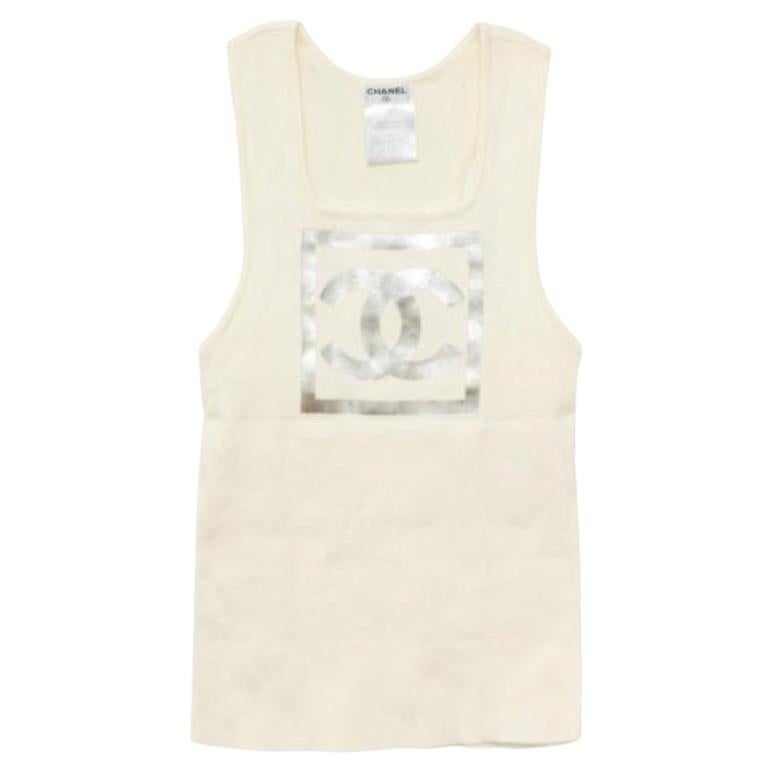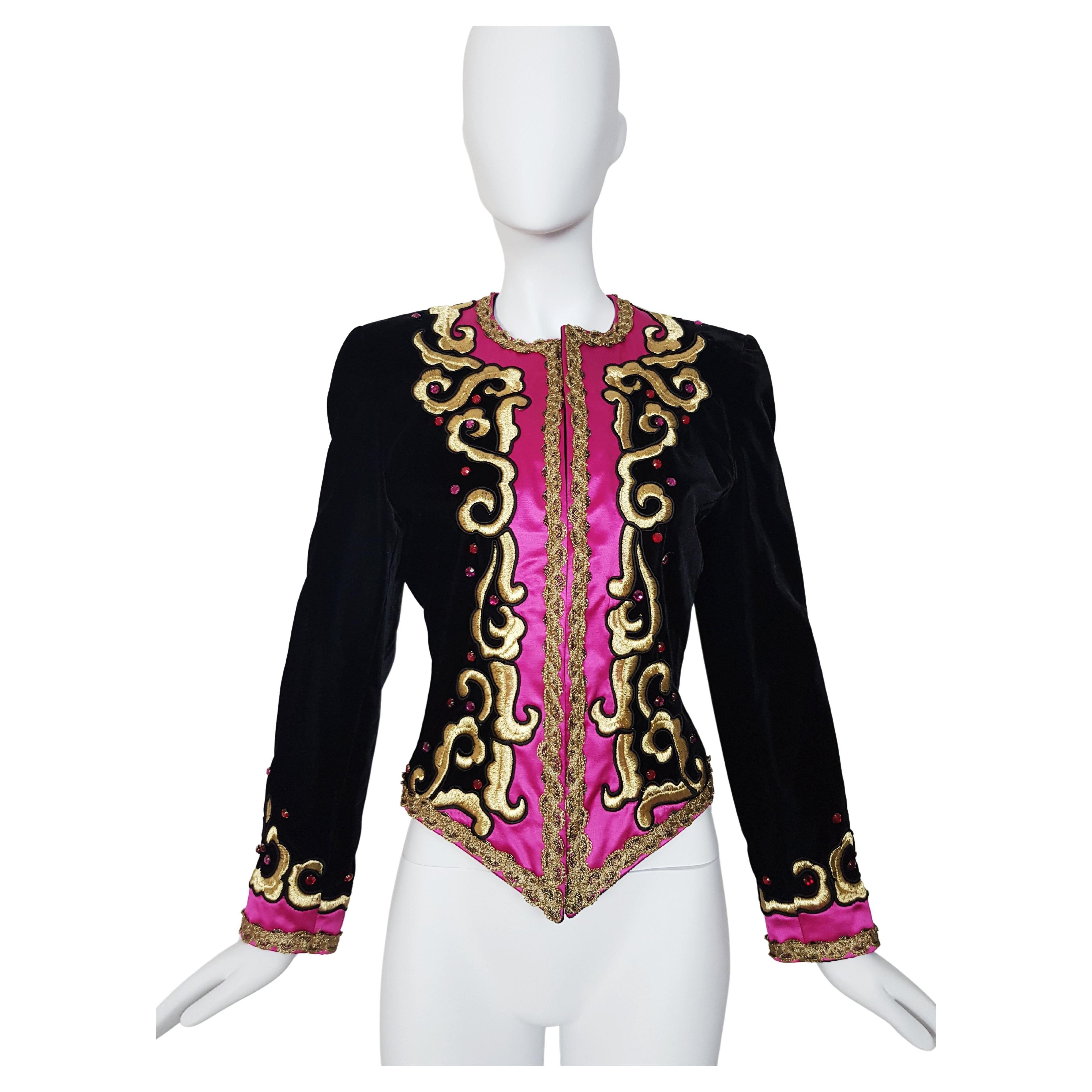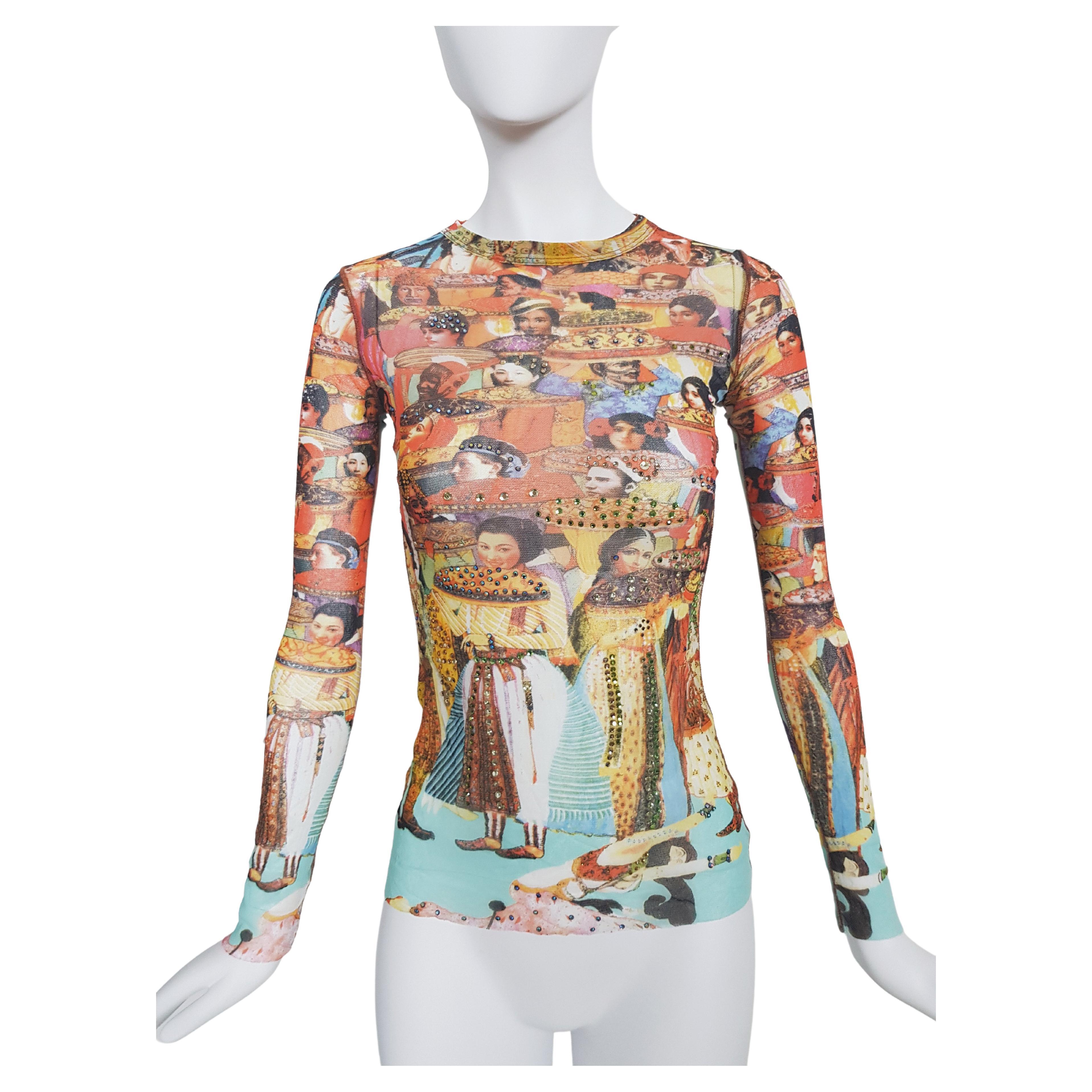Mariano Fortuny Off White Silk Delphos Gown
About the Item
Named after a Greek classical sculpture, the Delphos Gown was a simple column of vertical pleats permanently set in silk by a process never successfully duplicated.Fortunys delphos was an interpretation of the chiton, involving the introduction of his minute pleated fabrics. the columnar dress is either sleeveless, short or long sleeved, the neck is controlled by a drawstring and the sleeves can be closed on the shoulders by seaming or cording in a lacing, with glass bead trim.
In the early 20th century avant-garde american dancers Isadora Duncan and Ruth St. Denis wore Fortunys designs because of their interest in the body and movement ,and also their aesthetic appeal . Originally made to be worn as tea gowns for entertaining at home only, the delphos and peplos gowns were seen outside the home by the 1930s continuing the the trend to the present.
Length 62"
Shoulder 5.5"
Armhole 18"
Beads clear frosted with white stripe
Belt silver swirl face pattern
The pleats in the fabric allow the gown to expand to fit a range of sizes.
- Designer:
- Brand:
- Place of Origin:
- Period:
- Material Notes:Silk, glass, metallic pigments
- Condition:excellent.
- Seller Location:Riverdale, NY
- Reference Number:1stDibs: AU1012061766
Fortuny
Spanish fashion designer Mariano Fortuny was a true artist who worked with beautiful fabrics as his medium of choice. Although he showed talent in painting, sculpting, photography and architecture at an early age, fashion was where he really shined.
Fortuny was an innovator in the world of textile design, he drew on classical Greek tunics for his rich and interesting garments and worked with a revolutionary system for creating pleats. He designed a range of clothing for his couture house, and today, vintage Fortuny evening gowns, gemstone-colored day dresses, coats and accessories like drawstring bags are known for their fine craftsmanship and signature elegance.
Fortuny was born Mariano Fortuny y Madrazo in 1871 in Granada, into a family of artists. His father died when Fortuny was only three years old, and his mother moved the family to Paris. As a child, Fortuny was fond of experimenting and figuring out how things worked. He even dyed pieces of fabric from his family's textile collection, which had been amassed from shops around Europe.
In 1889, the family moved again, this time to Venice. Here, Fortuny found inspiration in the past, which would influence his future designs. Not long after, the young Fortuny set off to travel the continent. In 1897, he visited Paris and fell in love with a dressmaker named Henriette Negrin. She became his muse, his wife and his creative partner — Negrin worked with Fortuny on clothing designs and fabrics — and the two settled in the French capital.
A lifelong inventor, Fortuny began patenting his creations in 1901. By 1934, he had registered more than 20 patents. At the same time, his fashion career was taking off.
In 1907, he designed the Delphos gown with Negrin, which French novelist and essayist Marcel Proust described as "faithfully antique but markedly original." Fortuny had worked from his home until 1922 when increased demand required large-scale production. He opened a factory in Venice, where due to the scarcity of silk, he began experimenting with cotton.
In 1927, New York interior designer Elsie McNeill traveled to Paris to meet Fortuny and became his exclusive American distributor. She returned to the United States and introduced Fortuny's designs to New World audiences. Shops opened in Paris, New York and London. Toward the end of the 1930s, Fortuny returned to painting and stepped away from the busy fashion industry.
After Fortuny passed away in 1949, McNeill took over the label and continued running it until 1988, when it was purchased by the Riad family, who remain at the helm of Fortuny today.
On 1stDibs, find vintage Fortuny clothing and accessories.
- ShippingRetrieving quote...Ships From: Riverdale, NY
- Return PolicyThis item cannot be returned.
- Extremely Rare Mariano Fortuny Cotton DelphosBy FortunyLocated in Riverdale, NYThis extraordinarily rare dress is made of finely pleated white cotton. Few cotton pleated Fortuny dresses have been documented and survived.
Named after a Greek clas...CategoryEarly 20th Century Italian Art Deco Delphos Gowns
- Mariano Fortuny Black Stencilled Velvet Persian Style CoatBy FortunyLocated in Riverdale, NYThis three-quarter length black velvet persian coat was printed with metallic paints with Venetian glass buttons and silk loop closures at the center fr...Category
Early 20th Century Italian Art Deco Coats
- Mariano Fortuny Black Stencilled Velvet Long CoatBy FortunyLocated in Riverdale, NYFortuny's coats often take their inspiration from a myrid of references,renaissance,persian,arabic .These are often elaborately decorated in historical motifs surprisingly unrelated...Category
Early 20th Century Italian Art Deco Coats
- Mariano Fortuny Sienna Peplos GownBy FortunyLocated in Riverdale, NYThis dress is made of finely pleated sienna colored silk with silk cording along side seams,shoulders and tunic hem with multicolored glass beads threaded through the cording.
...CategoryEarly 20th Century Italian Art Deco Peplos
- Mariano Fortuny Pink Stencilled Velvet Persian Style CoatBy FortunyLocated in Riverdale, NYthis three-quarter length orange-red cut velvet jacket was printed with metallic paints with Venetian glass buttons and silk loop closures at the center front.
The han...CategoryEarly 20th Century Italian Art Deco Coats
- Mariano Fortuny Green Stencilled Velvet Long CoatBy FortunyLocated in Riverdale, NYFortuny translated the caftan as a loose fitting outer garment,usually made out of silk velvet crepe or gauze the fitted back and open front allowed for elaborate stenciled decoratio...Category
Early 20th Century Italian Art Deco Coats
- Roberto Cavalli Tiger Print Jersey Cocktail / Dinner Dress Size 46 EUBy Roberto CavalliLocated in New York, NYRoberto Cavalli tiger print ivory jersey cocktail dress with 3/4 length sleeves. This fun dress is form fitted, gathered at the bust with beautiful...Category
Early 2000s Italian Evening Dresses and Gowns
- Three Sam Kori George Courture Atelier Cashmere Sweater Coats. Priced Per PieceLocated in Buchanan, MITHREE SAM KORI GEORGE CASHMERE SWEATER COATS. Priced per sweater coat. Only worn once. 4-5 Ply Comprising of a white, red, and beige sweater coats Appr...Category
21st Century and Contemporary American Coats
- Chanel Sport Gorgeous Tank Top With Cc LogosBy ChanelLocated in Hoffman Estates, ILChanel Sport gorgeous tank top with CC logos. Specifications: Size: 36Category
Early 2000s French Sleeveless Shirts
- NEW 1980 ESCADA statement velvet embroidered jacketBy Margaretha Ley Escada, Escada Margaretha LeyLocated in Genève, CHNever worn (with tag and original price 1460 CHF) rare Escada by Margaretha Ley statement velvet jacket with embedded rhinestones. Edges of this jacket are elaborated with pink sati...Category
1980s German Jackets
- Colllector JEAN PAUL GAULTIER Asian mesh shirtBy Jean Paul Gaultier Soleil, Jean Paul GaultierLocated in Genève, CHRare Jean Paul Gaultier Early 00s mesh T-Shirt with vibrant Asian print, as seen on Beyoncé for InStyle Magazine (May 2003) shot by Fabrizio Ferri....Category
21st Century and Contemporary French T-Shirts
- Louis Vuitton Fabulous 60's Mod Red Tartan Coat with Fur Trim F/W 2004 Size 34FRBy Louis VuittonLocated in Saint Petersburg, FLLouis Vuitton - Runway collection coat Fall/Winter 2004. This chic red tartan coat is trimmed with fitch fur collar and cuffs. The coat is lined and closes...Category
Early 2000s French Coats
